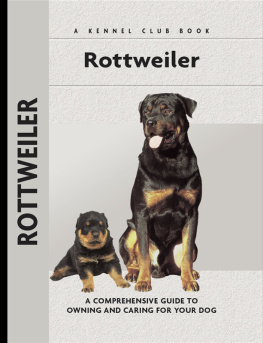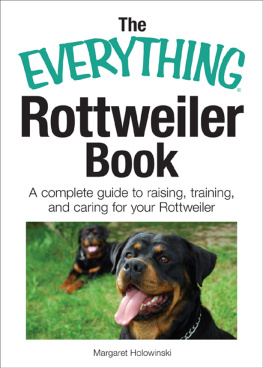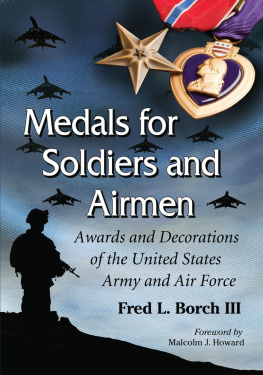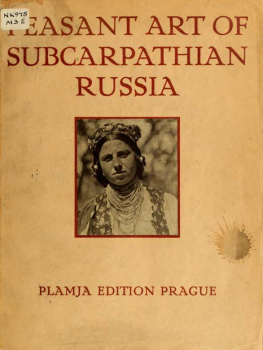
Physical Characteristics of the Rottweiler
(from the American Kennel Club breed standard)
Eyes: Of medium size, almond shaped with well fitting lids, moderately deep-set.
Ears: Of medium size, pendant, triangular in shape; set well apart, hanging forward with the inner edge lying tightlyagainst the head and terminatingat approximately mid-cheek.
Nose: Broad rather than round and always black.
Muzzle: Bridge is straight, broad at base with slight tapering towards tip. The end of the muzzle is broad with well developed chin.
Head: Of medium length, broad between the ears; forehead line seen in profile ismoderately arched; zygomatic arch and stop well developed with strong broad upper and lower jaws.
Neck: Powerful, well muscled, moderately long, slightly arched and without loose skin.
Forequarters: Shoulder blade is long and well laid back. Legs are strongly developed with straight, heavy bone, not set close together. Pasterns are strong, springy and almost perpendicular to the ground. Feet are round, compact with well arched toes, turning neither in nor out.

Body: The chest is roomy, broad and deep, reaching to elbow, with well pronounced forechest and well sprung, oval ribs. Back is straight and strong. Loin is short, deep and well muscled. Croup is broad, of medium length and only slightly sloping.
Tail: Docked short, close to body, leaving one or two tail vertebrae.
Hindquarters: Upper thigh is fairly long, very broad and well muscled. Stifle joint is well turned. Lower thigh is long, broad and powerful. Feet are somewhat longer than the front feet.
Coat: Outer coat is straight, coarse, dense, of medium length and lying flat.
Color: Always black with rust to mahogany markings. The demarcation between black and rust is to be clearly defined.
Size: Dogs24 inches to 27 inches. Bitches22 inches to 25 inches, with preferred size being mid-range of each sex.
Contents

Return to the Fatherland to meet the creators of the Rottweiler. Begin by tracing the ancient molossers of Rome to 8th-century Rottweil, and find out about this ex-butchers dog turned international superstar, flourishing in the US and beyond.

What makes this 100-pound guard dog the dog of choice for thousands? Find out if the Rottweiler is the right dog for you and your living situation. Learn about the breeds physical characteristics, personality, hereditary health concerns and more.

Learn the requirements of a well-bred Rottweiler by studying the description of the breed as set forth in the American Kennel Clubs breed standard. Both show dogs and pets must possess key characteristics as outlined in the breed standard.

Be advised about choosing a reputable breeder and selecting a healthy, typical puppy. Understand the responsibilities of ownership, including home preparation, acclimatization, the vet and prevention of common puppy problems.

Enter into a sensible discussion of dietary and feeding considerations, exercise, grooming, traveling and identification of your dog. This chapter discusses Rottweiler care for all stages of development.

By Charlotte Schwartz
Be informed about the importance of training your Rottweiler from the basics of house-training and understanding the development of a young dog to executing obedience commands (sit, stay, down, etc.).

Discover how to select a qualified vet and care for your dog at all stages of life. Topics include vaccinations, skin problems, dealing with external and internal parasites and common medical and behavioral conditions.

Consider the care of your senior Rottweiler, including the proper diet for a senior. Recognize the signs of an aging dog, both behavioral and medical; implement a special-care program with your vet and become comfortable with making the final decisions and arrangements for your senior Rottweiler.

Experience the dog show world in the conformation ring and beyond. Learn about the American Kennel Club, the different types of shows and the making up of a champion. Also learn about competitive trials like agility, obedience, tracking and herding.

Learn to recognize and handle behavioral problems that may arise with your Rottweiler. Topics discussed include separation anxiety, aggression, barking, chewing, digging, begging, jumping up, etc.
KENNEL CLUB BOOKS ROTTWEILLER
ISBN 13: 978-1-59378-203-0
Copyright 1998 Kennel Club Books An Imprint of I-5 Press A Division of I-5 Publishing, LLC
3 Burroughs, Irvine, CA 92618 USA
Cover Design Patented: US 6,435,559 B2 Printed in South Korea
All rights reserved. No part of this book may be reproduced in any form, by photostat, scanner, microfilm, xerography or any other means, or incorporated into any information retrieval system, electronic or mechanical, without the written permission of the copyright owner.
PHOTOS BY:
Norvia Behling, Liza Clancy, Doskocil, Isabelle Franais, Carol Ann Johnson, Bill Jonas, Nancy Liguori, Mikki Pet Products and Alice Roche.
Illustrations by Rene Low.

The Rottweilers unique coloration and high level of trainability have made the breed one of the worlds most recognizable and popular.

No matter how long I am owned by Rottweilers, I will always be fascinated by the unique rust markings over every dogs eyes and on the cheeks. I have been an impassioned student of the breed, its breeding, pedigrees, genetics and history, and still I am fascinated. In Australia, as I learned on a visit there, the eye marks are called pips, a charming and typically Aussie name for these marks! I know that many other breeds have distinctive color markings, but the Rottweiler stands out among the crowd, especially since he stands so tall and proud, as befits his remarkable German heritage.

Rottweilers are great herding dogs and are used by many sheep and cattle farmers.



























